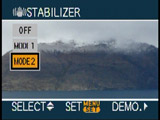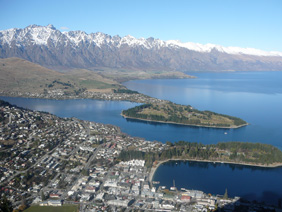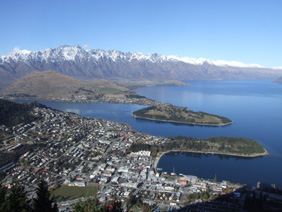Panasonic Lumix DMC-TZ1
-
-
Written by Gordon Laing
Panasonic DMC-TZ1 lens coverage
Lenses and Optical stabilisation / Screen and menus / Sensor and processing
The Panasonic TZ1 is equipped with a Leica DC Vario-Elmarit 10x optical zoom with a 35mm-equivalent range of 35-350mm and a focal ratio of f2.8~4.2; the actual focal length is 5.2-52mm. Note: if the image resolution isn’t set to the maximum 5 Megapixels, the TZ1 can employ the spare pixels to deliver a digital-like zoom extension giving a total range of 12.5x without loss of quality. The closest focusing distance is 5cm in Macro mode with the lens zoomed-out.
On a physically larger camera, a 10x optical zoom would be considered powerful, but given it’s squeezed within the compact body of the TZ1 is nothing short of remarkable. The secret lies with an internal prism and folded optics which allow the lens to zoom horizontally within the camera. According to Panasonic, it’s the world’s first integration of a retractive lens with folding optics.
A circular lever around the shutter release button operates the motorised zoom, and as expected the barrel extends as the focal length increases. What’s not expected though is the modest degree by which it extends: a mere 14mm at the maximum focal length. That’s less than plenty of 3x optical zooms we’ve seen and very discreet as seen from the photo above. The optics are protected by a cap which clips on the front, and thanks to the lens not extending at power-up, it wont try and prod it off.
To illustrate the coverage offered by the TZ1 we mounted it on a tripod and took the same scene with the lens fully zoomed-out, then fully zoomed-in – see below. To further show how impressive this range is given the TZ1’s dimensions, we repeated the shots using the considerably larger Fujifilm FinePix S9500 / S9000 which sports a similar optical zoom range.
As seen above and below, both cameras delivered fields corresponding to their respective equivalent focal lengths – ie, the Fujifilm S9500 / S9000 captured a larger field at wide angle, while the Lumix TZ1 zoomed-in a little tighter at telephoto; note the Fujifilm telephoto field is shifted to the left a little, but common areas like the path by the trees allow a comparison to be made.
Panasonic DMC-TZ1 coverage tele |
Fujifilm FinePix S9500 / S9000 coverage tele | |
 |  | |
| 5.2-52mm at 52mm, f4.2 (350mm equivalent) | 6.2-66.7mm at 66.7mm, f8 (300mm equivalent) |
Ultimately, the TZ1’s range is incredibly versatile, and even more so when you consider it’s delivered by a camera which could slip into a pocket. This capability is really brought home at times when others around you have more typical compact cameras with 3x to 5x zooms. Whether you’re taking opportunist shots of, say, wildlife or someone making a speech, the extra reach of the TZ1’s 10x optical zoom will have your subject occupying much more of the frame than those shooting with average compacts. It’s wonderful to have this capability in such a convenient package – our Gallery illustrates the kind of opportunities available.
Image stabilisation
Handholding any camera at effective focal lengths up to 350mm is going to be tricky, so to combat camera shake, Panasonic’s fitted the TZ1 with its Mega Optical Image Stabiliser OIS technology. This employs gyrosensors to detect any motion and shifts the lens in the opposite direction to compensate.
Panasonic claims up to three stops of compensation which corresponds to using exposures eight times slower than normal – so if the slowest exposure you could normally handhold at a given focal length was, say, 1/60, three stops of compensation should allow you to achieve the same result at 1/8.
 |
Pressing and holding the button on top of the camera with an icon of a shaky hand brings up the three OIS options. Mode 1 applies stabilisation constantly which can greatly aid composition, especially at longer focal lengths. Mode 2 only applies the stabilisation as you take the picture, which Panasonic claims better combats camera-shake, although you won’t see the effect as you compose the image. Finally, the third option switches the OIS off altogether. Note OIS is also available when recording movies, but only with Mode 1.
Panasonic Lumix DMC-TZ1 Mega OIS off |
Panasonic Lumix DMC-TZ1 Mega OIS Mode 1 |
Panasonic Lumix DMC-TZ1 Mega OIS Mode 2 | ||
 |  |  | ||
| 5.2-52mm at 5.2mm f2.8, 1/13, 80 ISO | 5.2-52mm at 5.2mm f2.8, 1/13, 80 ISO | 5.2-52mm at 5.2mm f2.8, 1/13, 80 ISO |
Above are crops from three examples of a bottle label taken with OIS disabled, followed by the two OIS modes. The photos were taken from a short distance in Macro mode. The original crops measured 320×240 pixels and therefore represent an area one eighth of the width and height of the full TZ1 image. Each crop has been reduced to 160×120 for reproduction here.
The images taken with OIS clearly show camera shake has been greatly reduced, and interestingly Mode 2 does seem slightly more effective than Mode 1 confirming Panasonic’s claims. In use though, Mode 1 is preferred as stabilisation applied during composition certainly helps at longer focal lengths. But if upon playback you’re finding camera shake creeping in, it’s nice to have the option to reshoot with the slightly more effective Mode 2.
Features continued…
Lenses and Optical stabilisation / Screen and menus / Sensor and processing


5.2-52mm at 5.2mm, f5 (35mm equivalent)
6.2-66.7mm at 6.2mm, f8 (28mm equivalent)




